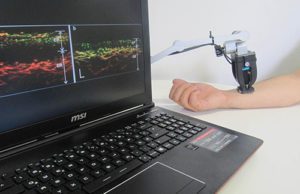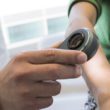
A newly developed tissue scanner allows looking under the skin of psoriasis patients. [Image from Helmholtz Zentrum München]
The new tissue scanner can give clinicians important information about the skin like the structure of skin layers and blood vessels.
People with psoriasis have skin cells that grow abnormally quickly, which causes psoriasis lesion buildups. It is characterized by raised, red, scaly patches on the skin that can cause itching, burning and stinging, according to the National Psoriasis Foundation. There is currently no known cause for psoriasis, but scientists say the immune system and genetics play a role in its development. It is estimated that 7.5 million Americans are currently living with psoriasis.
To evaluate how severe a psoriasis case is, physicians usually have to do a visual assessment of the features of the skin where the psoriasis is located.
“Unfortunately, these standards miss all parameters that lie below the surface of the skin, and may be subjective,” said Juan Aguitte, lead researcher on the device at the Institute of Biological and Medical Imaging at Helmholtz Zentrum München, in a press release.
The device, known as RSOM (raster-scan optoacoustic mesoscopy), evaluates beyond the surface of the skin. It features a weak laser pulse that excites the tissue. The tissue then absorbs energy and heats up, causing the tissue to expand and generate ultrasound waves. The ultrasound waves help create a high-resolution image of beneath the surface of the skin.
RSOM’s technology is compact enough that it can fit in the palm of your hand.
“This technology, which is easy to use and does not involve any radiation exposure or contrast agent, is allowing us to acquire the first new insights into the disease mechanisms. It also facilitates treatment decisions for physicians,” said Vasilis Ntziachristos, director of the Institute of Biological and Medical Imaging at Helmholtz Zentrum München and chair of Biological Imaging at the Technical University of Munich.
The scientists tested the efficiency of the device by testing cutaneous and subcutaneous tissues in people with psoriasis. RSOM allowed them to evaluate skin thickness, capillary density, number of vessels and total blood volume in the skin.
Researchers hope to use the imaging technology in the future to evaluate other diseases like skin cancer and diabetes.
[Want to stay more on top of MDO content? Subscribe to our weekly e-newsletter.]





